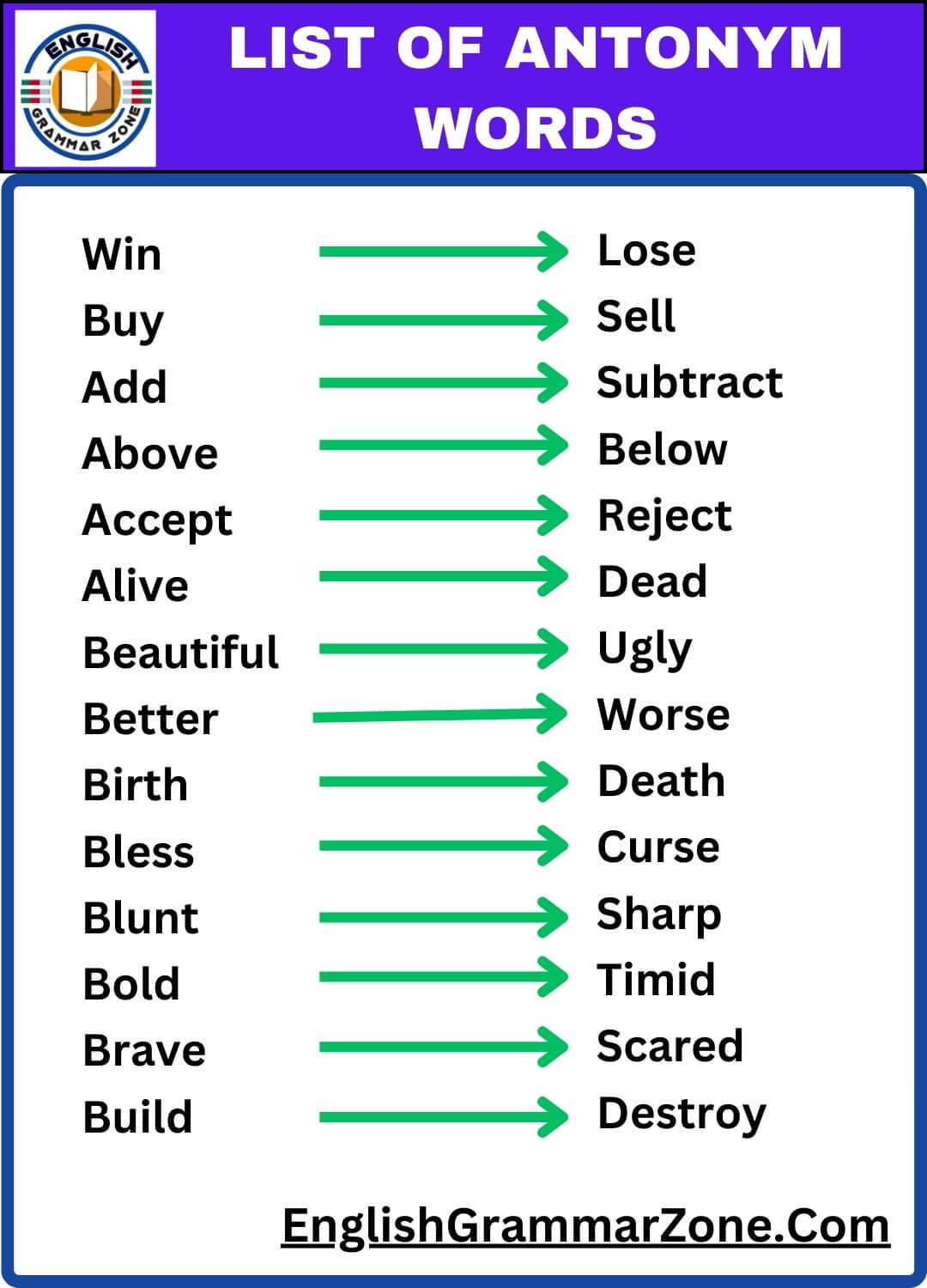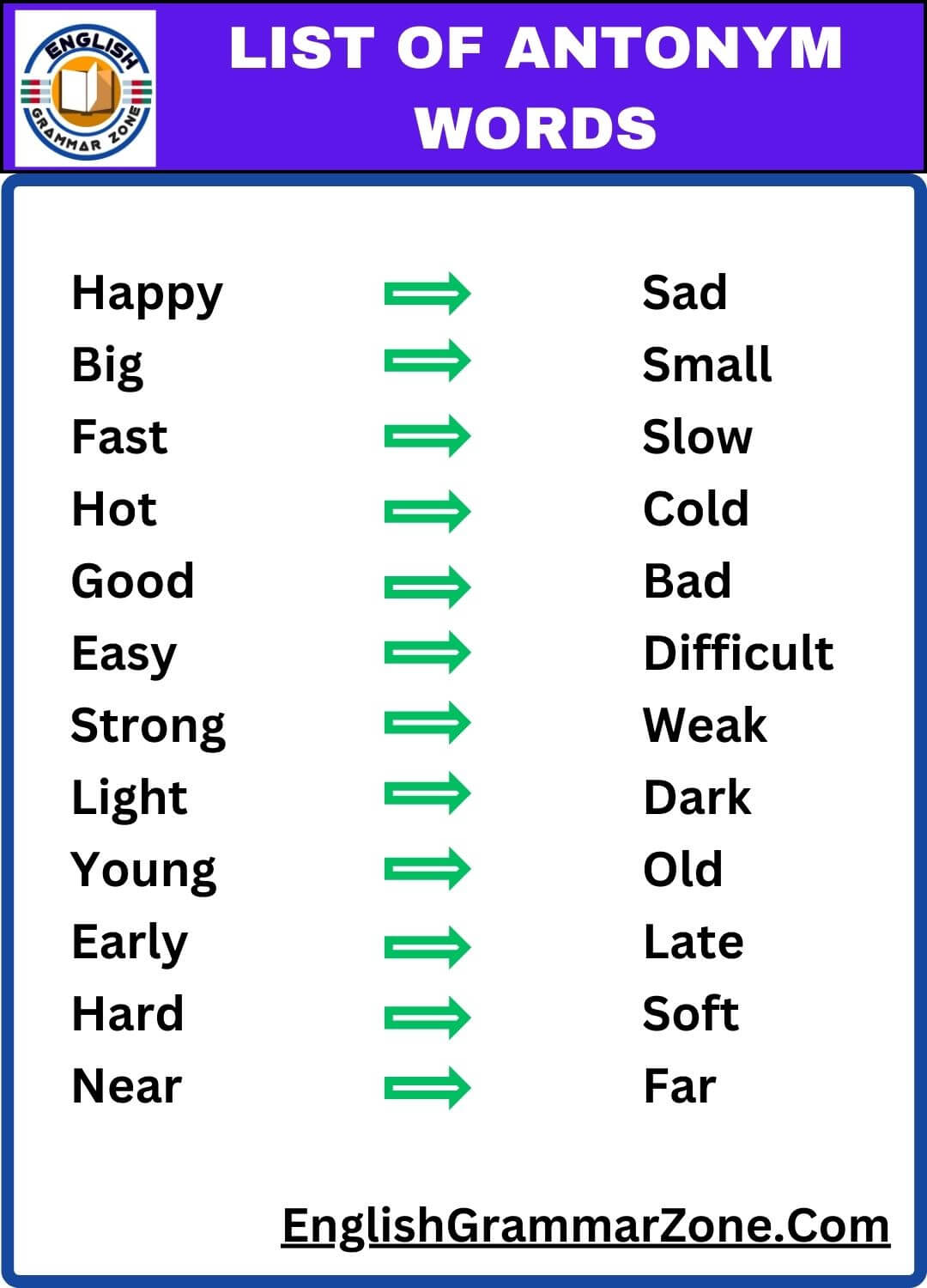In daily conversations and writing, knowing antonyms can significantly enhance how you express ideas and communicate effectively. Essential antonym pairs for everyday use are words that have opposite meanings and can help in building a stronger vocabulary. Whether you’re talking about emotions, sizes, directions, or time, antonyms are everywhere, and understanding them can make your communication clearer and more precise.
For example, when you’re describing the weather, you might use antonyms like “hot” and “cold” to convey contrasting temperatures. Similarly, when discussing a person’s mood, antonyms such as “happy” and “sad” come in handy to express feelings. Antonyms not only help to explain differences but also add richness to your speech, making it more varied and dynamic.
The use of antonym pairs is not just for vocabulary building; it also plays an essential role in writing, particularly in comparing and contrasting ideas. Understanding the subtle differences between words allows you to paint a more vivid picture in the minds of your listeners or readers. The good news is, learning essential antonym pairs doesn’t require a lot of effort—many of these word pairs are part of our everyday language.
In this article, we will explore some of the most common and useful antonym pairs that you can incorporate into your daily conversations and writing. Whether you’re a student, a professional, or simply someone looking to improve your vocabulary, understanding these pairs will help you communicate more effectively and confidently.
100 pairs of antonym words:
- Happy – Sad
- Big – Small
- Fast – Slow
- Hot – Cold
- Good – Bad
- Easy – Difficult
- Strong – Weak
- Light – Dark
- Young – Old
- Early – Late
- Hard – Soft
- Near – Far
- Clean – Dirty
- Tall – Short
- Rich – Poor
- Thick – Thin
- Loud – Quiet
- Full – Empty
- Safe – Dangerous
- Bright – Dim
- New – Old
- Heavy – Light
- Warm – Cool
- Brave – Cowardly
- Happy – Unhappy
- Sharp – Dull
- Wet – Dry
- Smart – Dumb
- Beautiful – Ugly
- Cheap – Expensive
- Thick – Thin
- Sweet – Sour
- Day – Night
- Open – Closed
- Large – Small
- Soft – Hard
- Fresh – Stale
- Awake – Asleep
- Full – Hungry
- Smooth – Rough
- Safe – Unsafe
- Success – Failure
- Strong – Feeble
- Yes – No
- Peace – War
- Love – Hate
- Friend – Enemy
- Correct – Incorrect
- Begin – End
- Arrive – Depart
- Win – Lose
- Buy – Sell
- Add – Subtract
- Above – Below
- Accept – Reject
- Alive – Dead
- Beautiful – Ugly
- Better – Worse
- Birth – Death
- Bless – Curse
- Blunt – Sharp
- Bold – Timid
- Brave – Scared
- Build – Destroy
- Calm – Agitated
- Careful – Careless
- Clear – Cloudy
- Close – Open
- Cold – Hot
- Come – Go
- Comedy – Drama
- Compliment – Insult
- Cool – Warm
- Create – Destroy
- Cry – Laugh
- Dangerous – Safe
- Dark – Light
- Deep – Shallow
- Down – Up
- Empty – Full
- Entrance – Exit
- Even – Odd
- Fail – Succeed
- Float – Sink
- Follow – Lead
- Foolish – Wise
- Forget – Remember
- Full – Empty
- Gentle – Harsh
- Gloomy – Cheerful
- Guilty – Innocent
- Health – Disease
- Hero – Villain
- Humid – Dry
- Import – Export
- Increase – Decrease
- Innocent – Guilty
- Junior – Senior
- Kind – Cruel
- Knowledge – Ignorance


Frequently Asked Questions About Essential Antonym Pairs for Everyday Use
What are antonym pairs?
Antonym pairs are two words that have opposite meanings. They help to highlight contrasts and are commonly used to compare and describe differences in things, emotions, or actions. For example, “hot” vs. “cold,” “big” vs. “small,” or “happy” vs. “sad.”
Why should I learn antonym pairs?
Learning antonym pairs enhances your vocabulary and improves communication. It allows you to express ideas more precisely, making your speech or writing clearer and more engaging. Antonyms help in describing differences and making comparisons, which are essential in effective communication.
How can antonyms improve my writing?
Using antonyms in writing adds variety and depth to your sentences. Instead of repeating the same word, you can switch between antonyms to emphasize differences and create a more colorful narrative. This technique also helps readers better understand the relationships between concepts.
Are antonym pairs the same in every language?
No, antonym pairs can vary across languages due to differences in culture, context, and grammar. While many antonyms exist in all languages, the specific pairs you encounter might not always directly translate. It’s essential to learn antonyms within the context of the language you’re using.
Can antonyms help in expanding my English vocabulary?
Yes! Learning antonym pairs helps you understand the range of meanings a single word can have, making it easier to learn synonyms and other related vocabulary. As you grasp more antonyms, you naturally enhance your overall language skills, helping you express yourself better.
In conclusion, mastering essential antonym pairs for everyday use is a simple yet effective way to improve your vocabulary. These word pairs are everywhere and can greatly enrich your ability to communicate clearly and confidently. By practicing regularly and incorporating them into your daily conversations, you’ll find yourself mastering language skills with ease!

